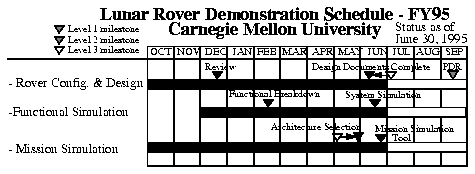The CMU Telerobotics program consists of two tasks:
Complete feasibility studies of power sources and make final decision on power scenario.
Test next generation prototype on lunar soil simulant.
Generate a blueprint for a projected 1000 km field trial using a lunar analogous Earth prototype in Winter 96-97 or Summer 97.

Moved operations to REC and began performing direct and safeguarded teleoperation experiments, both indoors and outdoors. To date, have driven Ratler continuously using direct teleoperation over 7 km, and using safeguarded teleoperation over 1 km.
Developed new algorithm for local obstacle avoidance that uses a statistical approach to estimating terrain traversability, rather than the previous geometrical approach based on wheel contacts. Preliminary tests indicate that it is significantly more reliable than the previous approach, and does not need to perform map merging.
Built sensor mount and control circuitry for laser proximity sensor. Continued developing sensor interpretation algorithms (presented at TRIWG). Developing techniques for wireless Ethernet transmission of images from the rover. Ported dead-reckoning code on board and rewrote on-board code to make control and dead-reckoning much more accurate.
Working with social scientist to design a study aimed at quantifying the advantage of safeguarding over conventional teleoperation techniques.
Released new version of TCA (8.0) that supports point-to-point communications and other improvements that make it significantly faster (4-5 times) for inter-process communications. Also, added some functionality requested by KSC for their tile inspection robot.
Integrate proximity sensor with on-board system. Test sensor interpretation algorithms.
Carry out user experiments to evaluate effectiveness of safeguarded teleoperation.
